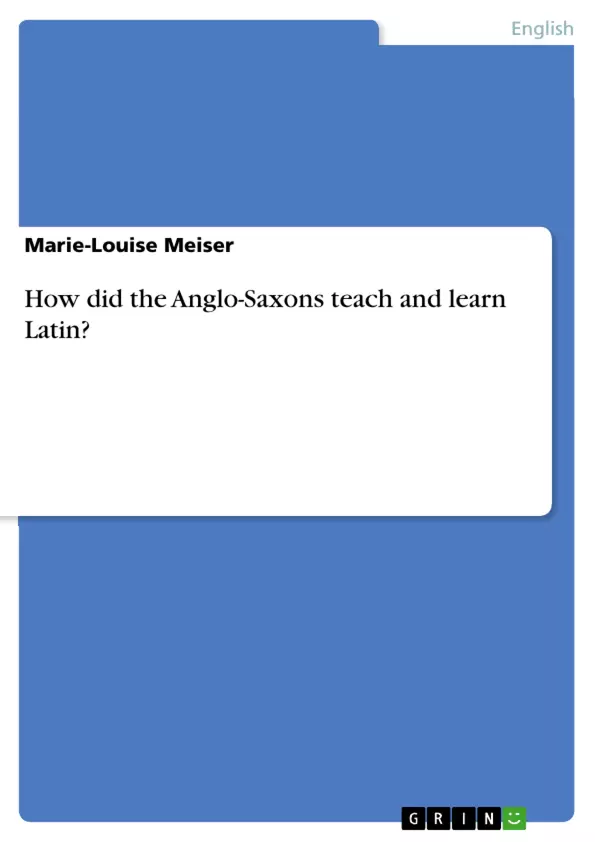This work answers the question, how the Anglo-Saxons taught and learned Latin.
The topic of how the Anglo-Saxons taught and learned Latin plays an important role in Anglo-Saxon history and was, and still is, investigated by quite a few historians and historical linguistics such as Patrizia Lendinara, Olga Timofeeva and Andy Orchard.
However, the knowledge about the Anglo-Saxons’ teaching and learning methods regarding Latin is not only of relevance from a historical perspective but also in the fields of contemporary theoretical linguistics, sociolinguistics and education studies. That is because the understanding of how the Anglo-Saxons learned and taught Latin allows us to draw parallels between the language that we call ‘English’ today and its connection to Latin, as well as shedding light on power relationships between languages constructed by society and the development of foreign language learning in educational settings.
In order to answer the given question, an awareness of the historical background, in particular, of how and when both the Latin language and the Anglo-Saxon tribes arrived in Britain, is vital.
Inhaltsverzeichnis (Table of Contents)
- Introduction
- The Roman Presence in Britain
- The Anglo-Saxon Invasion and the Emergence of the Heptarchy
- The Spread of Christianity and the Establishment of Monastic Schools
- Teaching and Learning Methods
- Latin Texts in Anglo-Saxon Education
- The Importance of Grammar
Zielsetzung und Themenschwerpunkte (Objectives and Key Themes)
This text explores the historical context of Latin education in Anglo-Saxon England. It examines how the Anglo-Saxons, who originally spoke Germanic dialects, were introduced to the Latin language and how it played a crucial role in their cultural and religious development.
- The influence of the Roman Empire on Britain and the introduction of Latin.
- The role of Christianity in the spread of Latin and the establishment of monastic schools.
- The methods used to teach and learn Latin, emphasizing writing and understanding.
- The use of specific texts, including poetry, riddles, and grammatical treatises, in education.
- The significance of Latin grammar and its impact on literary and cultural development.
Zusammenfassung der Kapitel (Chapter Summaries)
- This chapter introduces the topic of Latin education in Anglo-Saxon England and highlights its relevance to both historical and contemporary perspectives.
- The chapter delves into the Roman presence in Britain, explaining the introduction of Latin during the Roman conquest and its subsequent use as a 'high language' in Roman Britain.
- This chapter examines the arrival of the Anglo-Saxon tribes in Britain, the emergence of the Heptarchy, and the gradual shift in language and culture from Romano-British to Germanic.
- The chapter discusses the arrival of St. Augustine and the establishment of monastic schools in Canterbury and East Anglia, explaining their role in spreading Christianity and promoting Latin literacy.
- The chapter explores the teaching and learning methods used in Anglo-Saxon monastic schools, focusing on the emphasis on writing and understanding Latin, as well as the use of memorization techniques and specific texts like prayers and the psalter.
- The chapter delves into the specific Latin texts used in education, highlighting the significance of poetry, especially the works of Aldhelm, and riddles, which served didactic purposes.
- This chapter examines the importance of Latin grammar in Anglo-Saxon education, discussing the various grammatical treaties written by Anglo-Saxon masters and the role of Latin verse in education.
Schlüsselwörter (Keywords)
The primary focus of this text is on Latin education in Anglo-Saxon England, covering themes such as the Anglo-Saxon settlement, the spread of Christianity, monastic schools, teaching and learning methods, specific Latin texts, and the importance of grammar.
- Quote paper
- Marie-Louise Meiser (Author), 2018, How did the Anglo-Saxons teach and learn Latin?, Munich, GRIN Verlag, https://www.grin.com/document/1187661



